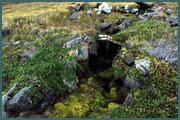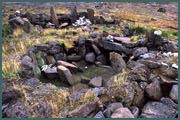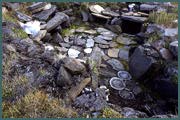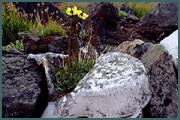| We spent a considerable amount of time exploring many of the campsites of the ancient
Dorset Inuit. Many of these have been extensively studied by archaelogists, and thus
have been "cleaned up" to provide a better view of the foundation of the dwelling.
Dwellings which had not been studied, were overgrown with several thousand years of moss
and grass, and thus only showed as a bump on the ground. The May 1981 issue of National
Geographic provides a good overview of the history of this area.
|

| Inuit Dwelling.
This shows the entrance to one of the dwellings. It was recessed into the ground, with a
stone or whale bone covering. You would have to slither on your stomach to get inside.
This protected them from the elements, and possibly the occassional polar bear.
|

| Inuit Dwelling.
Another view of the inside of the dwelling. We could often identify the hearthstone, and
other raised areas.
|

| Inuit Dwelling.
Whale bones and vertebrae disks were in evidence, and were often used in the construction
process.
|

| Arctic Poppies.
There were flowers and insects in abundance. These poppies used some whale bone as a
flowerpot. Alexandra Fiord is a natural oasis, and summer temperatures can go up to 60F.
Scientists were even able to grow potatoes in sheltered areas.
|




